watches the people with basic math skills fight to the death over the answer
If you really wanna see a bloodbath, watch this:
You know that a couple has two children. You go to the couple’s house and one of their children, a young boy, opens the door. What is the probability that the couple’s other child is a girl?
50%, since the coins are independent, right?
Oops, I changed it to a more unintuitive one right after you replied! In my original comment, I said “you flip two coins, and you only know that at least one of them landed on heads. What is the probability that both landed on heads?”
And… No! Conditional probability strikes again! When you flipped those coins, the four possible outcomes were TT, TH, HT, HH
When you found out that at least one coin landed on heads, all you did was rule out TT. Now the possibilities are HT, TH, and HH. There’s actually only a 1/3 chance that both are heads! If I had specified that one particular coin landed on heads, then it would be 50%
No. It’s still 50-50. Observing doesn’t change probabilities (except maybe in quantum lol). This isn’t like the Monty Hall where you make a choice.
The problem is that you stopped your probably tree too early. There is the chance that the first kid is a boy, the chance the second kid is a boy, AND the chance that the first kid answered the door. Here is the full tree, the gender of the first kid, the gender of the second and which child opened the door, last we see if your observation (boy at the door) excludes that scenario.
1 2 D E
B B 1 N
B G 1 N
G B 1 Y
G G 1 Y
B B 2 N
B G 2 Y
G B 2 N
G G 2 Y
You can see that of the scenarios that are not excluded there are two where the other child is a boy and two there the other child is a girl. 50-50. Observing doesn’t affect probabilities of events because your have to include the odds that you observe what you observed.
I was about to reply to you with a comment that started with “oh shit you’re right!” But as I wrote it I started rethinking and I’m not sure now.
Because I actually don’t think it matters whether we’re BB1 or BB2. They’re both only one generation of the four possible initial states. Which child opens the door is determined after the determination of which child is which gender. Basically, given that they have two boys, we’re guaranteed to see a boy, so you shouldn’t count it twice.
Still, I’m now no where near as confident in my answer as I was a moment ago. I might actually go and write the code to perform the experiment as I outlined in an earlier comment (let me know if you think that methodology is flawed/biased, and how you think it should be changed) to see what happens.
That’s a great idea let me know how it turns out. If you randomly pick the genders and randomly pick who opens the door, I think it will be 50-50. With these kinds of things they can get pretty tricky. Just because an explanation seems to make sense doesn’t mean it’s right so I’m curious!
I put it together. Here’s the code I wrote in Python.
import random genders = ['boy', 'girl'] def run(): other_child_girls = 0 for i in range(10000): other_child = get_other_child() if other_child == 'girl': other_child_girls += 1 print(other_child_girls) def get_other_child(): children = random.choices(genders, k=2) first_child_index = random.randint(0, 1) first_child = children[first_child_index] if first_child == 'boy': other_child_index = (first_child_index + 1) % 2 return children[other_child_index] # Recursively repeat this call until the child at the door is a boy # (i.e., discard any cases where the child at the door is a girl) return get_other_child() if __name__ == '__main__': run()And it turns out you were right. I ran it a few times and got answers ranging from 4942 to 5087, i.e., clustered around 50%.
This is a ridiculous argument when taken to the extreme. Say you have three bags. Bag A contains 100 blue marbles. Bag B contains 99 blue marbles and 1 red marble. Bag C contains 100 red marbles. You reach into a random bag and draw a red marble. You’ve only eliminated bag A. Would you say it is a 50-50 whether you are left with a bag now containing 99 blue marbles or 99 red marbles? No, the fact that you drew a red marble tells you something about the composition of the bag you drew from. The odds that you drew out of bag B is 1/101, the total number of red marbles in bag B divided by the total number of red marbles across all bags. The odds that you are dealing with bag C is 100x that.
Now let’s say you have 4 bags. BB, BR, BR, and RR. You draw an R. There is a 50% chance you are dealing with bag 2 or 3 because together they contain 2 out of 4 R. There is also a 50% chance you are dealing with bag 4. So it is equally likely that you draw either color of marble if you take the remaining marble out of the bag you randomly selected despite there being twice as many BR bags as RR bags.
This is basically Monty Hall right? The other child is a girl with 2/3 probability, because the first one being a boy eliminates the case where both children are girls, leaving three total cases, in two of which the other child is a girl (BG, GB, BB).
Actually, it’s a Monty Hall problem because a door is opened.
There’s quite a few calculators that get this wrong. In college, I found out that Casio calculators do things the right way, are affordable, and readily available. I stuck with it through the rest of my classes.
Sharp as well.
Ditto for Sharp. It’s really only Texas Instruments that is the ongoing exception to the rule.
Casio does a wonderful job, and it’s a shame they aren’t more standard in American schooling. Texas Instruments costs more of the same jobs, and is mandatory for certain systems or tests. You need to pay like $40 for a calculator that hasn’t changed much if at all from the 1990’s.
Meanwhile I have a Casio fx-115ES Plus and it does everything that one did, plus some nice quality of life features, for less money.
If you’re lucky, you can find these TI calculators in thrift shops or other similar places. I’ve been lucky since I got both of my last 2 graphing calculators at a yard sale and thrift shop respectively, for maybe around $40-$50 for both.
My Casio calculators get this wrong, even the newer ones. BTW the correct answer is 16, right?
the correct answer is 16, right?
- 16 is the right answer if you use PEMDAS only:
(8 ÷ 2) × (2 + 2) - 1 is the right answer if you use implicit/explicit with PEMDAS:
8 ÷ (2 × (2 + 2)) - both are correct answers (as in if you don’t put in extra parentheses to reduce ambiguity, you should expect expect either answer)
- this is also one of the reasons why postfix and prefix notations have an advantage over infix notation
- postfix (HP, RPN, Forth):
2 2 + 8 2 ÷ × . - prefix (Lisp):
(× (÷ 8 2) (+ 2 2))
- postfix (HP, RPN, Forth):
16 is the right answer if you use PEMDAS only: (8 ÷ 2) × (2 + 2)
You added brackets and changed the answer. 2(2+2) is a single term, and if you break it up then you change the answer (because now the (2+2) is in the numerator instead of in the denominator).
1 is the right answer
The only right answer
both are correct answers
Nope, 1 is the only correct answer.
this is also one of the reasons why postfix and prefix notations have an advantage over infix notation
Except they don’t. This isn’t a notation problem, it’s a people don’t remember the rules of Maths problem.
prefix notation doesn’t need parentheses either though, at least in this case. lisp uses them for readability and to get multiple arity operators. infix doesn’t have any ambiguity either if you parenthesize all operations like that.
infix doesn’t have any ambiguity either if you parenthesize all operations like that
There isn’t any ambiguity even if you don’t.
- 16 is the right answer if you use PEMDAS only:
Yes
8 / 2 (2+2)
8 / 2 (4)
4 (4)
16
No
8 / 2 (2+2)
8 / 2 (4)
8 / 8
1
No. Order of operations is left to right, not right to left. 1 is wrong.
Order of operations is left to right
Order of operations is BEDMAS, THEN left to right within each operator.
1 is wrong
1 is the only correct answer.
Pemdas.
Multiplication comes before division.
1 is the correct answer.
1 is the correct answer, but it’s because Brackets comes before Division - there is no Multiplication in this problem.
That’s wrong. Multiplication and division have equal precedence, same as addition and subtraction. You do them left to right. PEMDAS could be rewritten like PE(MD)(AS). After parentheses and exponents, it"s Multiplication and division together, then addition and subtraction together. They also teach BODMAS some places, which is “brackets, order, division and multiplication, addition and subtraction” Despite reversing the division and multiplication, it doesn’t change the order of operations. They have the same priority, so they are just done left to right. PEMDAS and BODMAS are the different shorthand for the same order of operations.
There’s an argument to be made that implicit multiplication comes before division, resulting in the answer 1, but all multiplication? That’s wrong, full-stop. You calculate (explicit) multiplication and division in one step, left to right. Reason being that division is technically just multiplying by the reciprocal.
Yes
No.
8 / 2 (4) 8/(2x4) 8/8 1
deleted by creator
No, 8 / 2 happens before 2 * 4
That’s (2x4). Doing division before brackets goes against the order of operations rules.
deleted by creator
Division and multiplication are equal in the order of operations
I didn’t say they weren’t. I said…
Doing division before brackets goes against the order of operations rules
You did 8/2x4, which is the same as (8/2)(2+2), which isn’t the same as 8/2(2+2)=8/2(4)=8/(2x4).
Depends on the system you use. Most common system worldwide and in the academic circles (the oldest of the two) has 1 as the answer.
Depends on the system you use
There are no other systems - only people who are following the actual rules of Maths and those who aren’t. And yes, 1 is the correct answer
Different compilers have robbed me of all trust in order-of-operations. If there’s any possibility of ambiguity - it’s going in parentheses. If something’s fucky and I can’t tell where, well, better parenthesize my equations, just in case.
This is best practice since there is no standard order of operations across languages. It’s an easy place for bugs to sneak in, and it takes a non-insignificant amount of time to debug.
there is no standard order of operations across languages
Yes there is. The rules of Maths are universal.
It’s an easy place for bugs to sneak in
But that’s because of programmers not checking the rules of Maths first.
Different compilers
Different programmers.
it’s going in parentheses
Unfortunately some places don’t care where you’ve put brackets, they’ll just go ahead and change it anyway. Welcome to my quest to educate.
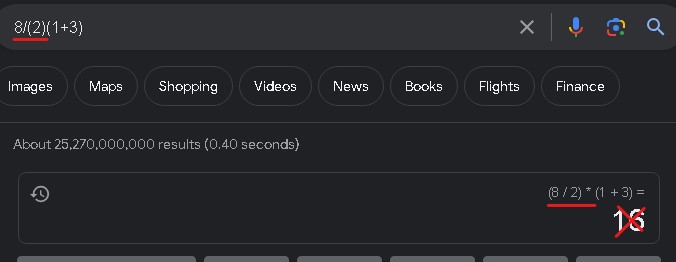
That’s the same ambiguity, numbnuts. Your added parentheses do nothing. If you wanted to express the value 8 over the value 2*(1+3), you should write 8/(2*(1+3)). That is how you eliminate other valid interpretations.
As illustration of why there are competing valid interpretations: what human being is going to read “8/2 * (1+3)” as anything but 4*4? Those spaces create semantic separation. But obviously most calculators don’t have a spacebar, any more than they have to ability to draw a big horizontal line and place 2(1+3) underneath it. Ambiguous syntax for expressing mathematics is not some foundation-shaking contradiction. It’s a consequence of limitations in how we express even the most concrete ideas.
“The rules of math” you keep spamming about are not mathematical proofs - they’re arbitrary decisions made by individuals and organizations. In many cases the opposite choice would be equally sensible. Unlike the innate equivalence of multiplication and division, where dividing by two and multiplying by half are interchangeable. Same with addition and subtraction.
Do you want to argue that 8 - (2) + (1+3) should be 2?
Your added parentheses do nothing
So you’re saying Brackets aren’t first in order of operations? What do you think brackets are for?
If you wanted to express the value 8 over the value 2*(1+3), you should write 8/(2*(1+3))
or, more correctly 8/2(1+3), as per the rules of Maths (we never write unnecessary brackets).
That is how you eliminate other valid interpretations
There aren’t any other valid interpretations. #MathsIsNeverAmbiguous
what human being is going to read “8/2 * (1+3)” as anything but 4*4
Yes, that’s right, but 8/2x(1+3) isn’t the same as 8/2(1+3). That’s the mistake that a lot of people make - disobeying The Distributive Law.
Those spaces
…have no meaning in Maths. The thing that separates the Terms, in your example, is the multiply. i.e. an operator.
most calculators don’t have a spacebar
…because it’s literally meaningless in Maths.
any more than they have to ability to draw a big horizontal line and place 2(1+3) underneath it
Some of them can actually.
“The rules of math” you keep spamming about are not mathematical proofs
You should’ve read further on then. Here’s the proof.
they’re arbitrary decisions made by individuals
No, they’re a natural consequence of the way we have defined operators. e.g. 2x3=2+2+2, therefore we have to do multiplication before addition.
In many cases the opposite choice would be equally sensible
2+2x3=2+6=8 the correct answer, but if I do addition first…
2+2x3=4x3=12, which is the wrong answer. How is getting the wrong answer “equally sensible” as getting the right answer?
Do you want to argue that 8 - (2) + (1+3) should be 2?
No, why would I do that? 8-(2+1+3) does equal 2 though.
You are a smug idiot.
8/2(1+3) is exactly the sort of thing programs love to misinterpret. I don’t give a shit what “rules of math” you insist are super duper universal, or what “we” do. They are not reliable. Clear parentheses are. Insisting you’re correct is not relevant. You stumbled into a pragmatic issue with grand philosophical assurances that aren’t even sound.
Yes, that’s right, but 8/2x(1+3) isn’t the same as 8/2(1+3).
… no, that’s fucking stupid.
Some of them can actually.
Hence the word “most.” Your cocksure months-late manic episode across this thread is the most “akshually” thing I have ever witnessed.
Here’s the proof.
You dense bastard! That’s a category error! You can’t prove that 2(3) means something different from 2*3. It’s only convention! It’s a thing we made up, unlike actual mathematical proofs, which are laws of the universe. If everyone disagreed with that then it would stop being true. That’s not a sentence you can say about anything that has a proof, instead of some evidence.
You keep talking about “rules of math” when what you mean is rules of this particular notation. Reverse Polish Notation doesn’t have this issue, at all. Distribution is not even possible in RPN. So however important you think it might be… it’s not universal.
[Those spaces] have no meaning in Maths.
THAT’S THE POINT, NUMBNUTS. It’s semantic separation that human beings will read in for context. Which they need, because some grammars have ambiguities, which can only be resolved by convention. Like how -6 is a number, and you can add or multiply -6, but 1 + -6 looks kinda weird, -6(3) is fine, and (3) -6 is asking for trouble.
The convention overwhelmingly used in computation is that parentheses are resolved first. Nothing is distributed over them - they are evaluated, and then used. In exactly the same way that multiplication can be treated as repeated addition, operations on parentheticals are treated as operations on equations reduced to scalars. It doesn’t fucking mean anything, to say 8/2*(1+3) is different from 8/2(1+3), because in the notation used by coders, they both become 8/2*4.
You might as well barge in pick a fight with N=N+1.
You are a smug idiot
That’s your colloquialism for Maths teachers. Ok, got it.
8/2(1+3) is exactly the sort of thing programs love to misinterpret.
Programs, written by programmers, who have forgotten the rules of Maths.
that’s fucking stupid
So you’re saying the rules of Maths are stupid. Got it.
You can’t prove that 2(3) means something different from 2*3. It’s only convention!
No, it’s a rule of Maths - it’s literally the opposite operation to factorising.
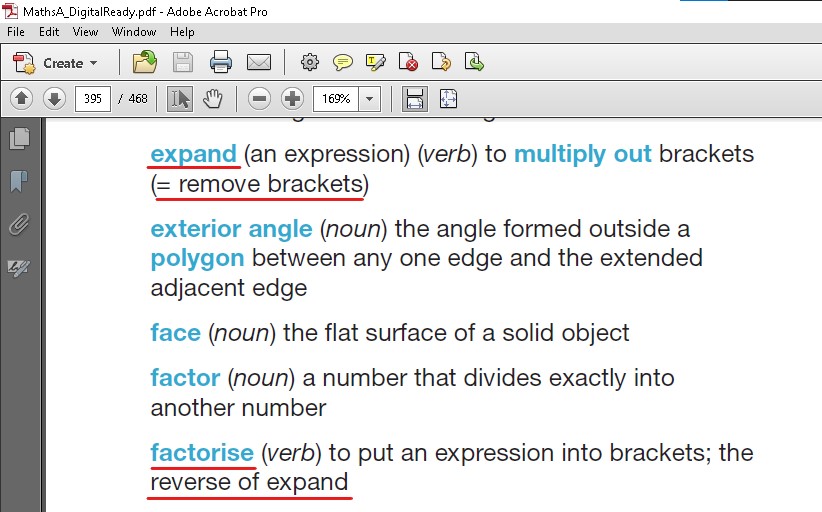
It’s a thing we made up
Nothing in Maths is made up. It’s based on our observations of how things work.
mathematical proofs, which are laws of the universe
Now you’re getting it.
this particular notation
…which is Maths.
Reverse Polish Notation doesn’t have this issue, at all
Neither does infix notation. All notations have to obey the rules of Maths, since the rules of Maths are universal.
Distribution is not even possible in RPN
Second hit in my Google results…

(3) -6 is asking for trouble
It’s -3 - where’s the trouble?
say 8/2*(1+3) is different from 8/2(1+3), because in the notation used by coders, they both become 8/2*4
Welcome to why almost every single e-calculator is wrong (as opposed to handheld calculators) - MathGPT gets it right.
Nothing in Maths is made up. It’s based on our observations of how things work.
The notation and syntax of how we express that, is made-up. There’s multiple options. There’s disagreements. Fuck me sideways, you are a teacher, and you can’t figure out how being off-topic works?
Evidently not, as you flip between ‘this particular notation is the notation!’ to ‘of course other notations exist’ and suffer zero cognitive dissonance. By capital-M “Maths,” do you mean the notation on paper, or the underlying laws-of-reality stuff? It depends! It’s ambiguous and requires context, or maybe you’re just factually wrong at least one of those times, and either way, that means it’s plainly not THE SAME KIND OF THING as the laws-of-reality stuff.
It’s a category error. You can prove that the word prove isn’t spelled proove, for some reason, but the heavens would not bend the other direction if that changed. We could swap square braces and parenthesis and nothing would be different. We could use the glyph “&” instead of “7.” These details are mutable and completely fucking arbitrary. But then & - 6 = 1, and you could never proove otherwise.
Second hit in my Google results…
Shows B being subtracted from A before that value is multiplied by C. It’s not distribution. It’s evaluating the parenthetical.
It’s -3 - where’s the trouble?
The fact it’s 3 and -6, not 3 - 6. Which is why I explicitly mentioned that -6 was a number, and used two other examples with -6. I wasn’t just making conversation. Jesus fucking Christ, a state trusts you with the education of children.
According to the textbook you’re now screenshotting at people, A(B) and (B)A are both correct - yes? They’re both valid? And spaces have no impact on an equation? And writing equations like -6 + 1 are fine, instead of (-6) + 1, since you don’t want needless parentheses?
‘this particular notation is the notation!’ to ‘of course other notations exist’
The notation for division in some countries is the obelus, in other countries it’s a colon. Whatever country you’re in, the notation for that country is the notation for division (be it an obelus or a colon).
Maths,” do you mean the notation on paper, or the underlying laws-of-reality stuff
Both! Whatever notation your country uses, all the rules for Maths and use of that Maths notation are defined.
It’s ambiguous
No, it’s not.
It’s not distribution. It’s evaluating the parenthetical
And Distribution applies to brackets/parentheses where they have a coefficient. In other words, same same.
it’s 3 and -6, not 3 - 6
You didn’t put a comma between 3 and -6, so no, it’s not 3 and -6, it’s 3-6. That’s what you wrote, that’s what it is.
a state trusts you with the education of children
Related - have you noticed how children never get this wrong? It’s only adults who’ve forgotten the rules of Maths who get it wrong.
According to the textbook you’re now screenshotting at people, A(B) and (B)A are both correct - yes? They’re both valid? And spaces have no impact on an equation? And writing equations like -6 + 1 are fine, instead of (-6) + 1, since you don’t want needless parentheses?
Yes (though the latter is unconventional), yes (though the latter is unconventional), yes, yes (though unconventional - 1-6 is the conventional way to write that), yes, yes.
This is the way. It’s an intentionally ambiguously written problem to cause this issue depending on how and where you learned order of operations to cause a fight.
intentionally ambiguously written
#MathsIsNeverAmbiguous
learned order of operations to cause a fight
The order of operations are the same everywhere. The fights arise from people who don’t remember them.
Please see this section of Wikipedia on the order of operations.
The “math” itself might not be ambiguous, but how we write it down absolutely can be. This is why you don’t see actual mathematicians arguing over which one of these calculators is correct - it is not either calculator being wrong, it is a poorly constructed equation.
As for order of operations, they are “meant to be” the same everywhere, but they are taught differently. US - PEMDAS vs UK - BODMAS (notice division and multiplication swapped places). Now, they will say they are both given equal priority, but you can’t actually do all of the multiplication and division at one time. Some are taught to simply work left to right, while others are taught to do multiplication first; but we are all taught to use parentheses correctly to eliminate ambiguity.
Please see this section of Wikipedia on the order of operations
That section is about multiplication, and there isn’t any multiplication in this expression.
The “math” itself might not be ambiguous, but how we write it down absolutely can be
Not in this case it isn’t. It has been written in a way which obeys all the rules of Maths.
This is why you don’t see actual mathematicians arguing over which one of these calculators is correct
But I do! I see University lecturers - who have forgotten their high school Maths rules (which is where this topic is taught) - arguing about it.
it is not either calculator being wrong
Yes, it is. The app written by the programmer is ignoring The Distributive Law (most likely because the programmer has forgotten it and not bothered to check his Maths is correct first).
US - PEMDAS vs UK - BODMAS
Those aren’t the rules. They are mnemonics to help you remember the rules
notice division and multiplication swapped places
Yes, that’s right, because they have equal precedence and it literally doesn’t matter which way around you do them.
you can’t actually do all of the multiplication and division at one time
Yes, you can!
Some are taught to simply work left to right
Yes, that’s because that’s the easy way to obey the actual rule of Left associativity.
we are all taught to use parentheses correctly to eliminate ambiguity
Correct! So 2(2+2) unambiguously has to be done before the division.
Just out of curiosity, what is the first 2 doing in “2(2+2)”…? What are you doing with it? Possibly multiplying it with something else?
there isn’t any multiplication in this expression.
Interesting.
I really hope you aren’t actually a math teacher, because I feel bad for your students being taught so poorly by someone that barely has a middle school understanding of math. And for the record, I doubt anyone is going to accept links to your blog as proof that you are correct.
Just out of curiosity, what is the first 2 doing in “2(2+2)”…? What are you doing with it? Possibly multiplying it with something else?
Distributing it, as per The Distributive Law. Even Khan Academy makes sure to not call it “multiplication”, because that refers literally to multiplication signs., which, as I said, there aren’t any in this expression - only brackets and division (and addition within the brackets).

I feel bad for your students
My students are doing well thanks.

I doubt anyone is going to accept links to your blog as proof that you are correct
You mean the blog that has Maths text book references, historical Maths documents, and proofs? You know proofs are always true, right? But thanks for the ad hominem anyway, instead of any actual proof or evidence to support your own claims.
Please Excuse My Dear Aunt Sally, she downloaded a shitty ad-infested calculator from the Google Play store.
For anyone like me who has math as their worst subject: PEMDAS.
PEMDAS is an acronym used to mention the order of operations to be followed while solving expressions having multiple operations. PEMDAS stands for P- Parentheses, E- Exponents, M- Multiplication, D- Division, A- Addition, and S- Subtraction.
So we gotta do it in the proper order. And remember, if the number is written like
2(3)then its multiplication, as if it was written2 x 3or2 * 3.So we read
8/2(2+2)and need to do the following;- Read the Parentheses of
(2 + 2)and follow the order of operations within them, which gets us 4. - Then we do
2(4)which is the same as2 x 4which is8 8 / 8is1.
The answer is 1. The old calculator is correct, the phone app which has ads backed into it for a thing that all computers were invented to do is inaccurate.
Turns out I’m wrong, but I haven’t been told how or why. I’m willing to learn if people actually tell me
Well, I don’t know what you said originally, so I don’t know what it is you were told was wrong - 1 or 16? 😂 The correct answer is 1.
Anyhow, I have an order of operations thread which covers literally everything there is to know about it (including covering all the common mistakes and false claims made by some). It includes textbook references, historical Maths documents, worked examples, proofs, memes, the works! I’m a high school Maths teacher/tutor - I’ve taught this topic many times.
Well that’s just wrong… Multiplication and division have equal priorities so they are done from left to right. So: 8 / 2 * (2 + 2)=8 / 2 * 4=4 * 4=16
8 / 2 * (2 + 2)
That’s not the same as 8 / 2 (2 + 2). In the original question, 2(2+2) is a single term in the denominator, when you added the multiply you separated it and thus flipped the (2+2) to be in the numerator, hence the wrong answer.
Implicit multiplication takes priority over explicit multiplication or division. 2(2+2) is not the same thing as 2*(2+2).
Correct! 2(2+2) is a single term - subject to The Distributive Law - and 2x(2+2) is 2 terms. Those who added a multiply sign there have effectively flipped the (2+2) from being in the denominator to being in the numerator, hence the wrong answer.
But it’s not called “implicit multiplication” - it’s Terms and/or The Distributive Law which applies (and they’re 2 separate rules, so you cannot lump them together as a single rule).
Not quite, pemdas can go either from the left or right (as long as you are consistent) and division is the same priority as multiplication because dividing by something is equal to multiplying by the inverse of that thing… same as subtraction being just addition but you flip the sign.
8×1/2=8/2 1-1=1+(-1)
The result is 16 if you rewrite the problem with this in mind: 8÷2(2+2)=8×(1/2)×(2+2)
8÷2(2+2)=8×(1/2)×(2+2)
No, that’s wrong. 2(2+2) is a single term, and thus entirely in the denominator. When you separated the coefficient you flipped the (2+2) into the numerator, hence the wrong answer. You must never add multiplication signs where there are none.
I’ve never had anyone tell me operations with the same priority can be done either way, it’s always been left to right.
I’ve never had anyone tell me operations with the same priority can be done either way, it’s always been left to right
It’s left to right within each operator. You can do multiplication first and division next, or the other way around, as long as you do each operator left to right. Having said that, you also can do the whole group of equal precedence operators left to right - because you’re still preserving left to right for each of the two operators - so you can do multiplication and division left to right at the same time, because they have equal precedence.
Having said that, it’s an actual rule for division, but optional for the rest. The actual rule is you have to preserve left-associativity - i.e. a number is associated with the sign to the left of it - and going left to right is an easy way to do that.
I’ve always heard it that way too but I think it is for consistency with students, imo Logically, if you are looking at division = multiplying by inverse and subtraction = adding the negative, you should be able to do it both ways. Addition and multiplication are both associative, so we can do 1+2+3 = (1+2)+3 = 1+(2+3) and get the same answer.
But subtraction and division are not associative. Any time you work on paper, 2 - 2 - 2 would equal -2. That is, (2-2)-2=0-2=-2. If you evaluate right to left, you get 2-2-2=2-(2-2)=2-0=2
2-(2-2)
But you broke the rule of left-associativity there. You can go right to left provided you keep each number with the sign to it’s left (and you didn’t do that when you separated the first 2 in brackets from it’s minus sign).
Correct, subtraction and division are not associative. However, what is subtraction if not adding the opposite of a number? Or division if not multiplying the inverse? And addition and multiplication are associative.
2-2-2 can be written as 2 + (-2) + (-2) which would equal -2 no matter if you solve left to right, or right to left.
In your example with the formula from right to left, distributing the negative sign reveals that the base equation was changed, so it makes sense that you saw a different answer.
2 - (2 - 2) = 2 + ((-2) + 2) = 2
Uh… no the 1 is wrong? Division and multiplication have the same precedence, so the correct order is to evaluate from left to right, resulting in 16.
There’s no multiplication in this question - multiplication refers literally to multiplication signs - only division and brackets, and addition within the brackets. So you have to use The Distributive Law to solve the brackets, then do the division, giving you 1.
The problem is that the way PEMDAS is usually taught multiplication and division are supposed to have equal precedence. The acronym makes it look like multiplication comes before division, but you’re supposed to read MD and as one step. (The same goes for addition and subtraction so AS is also supposed to be one step.) It this example the division is left of the multiplication so because they have equal precedence (according to PEMDAS) the division applies first.
IMO it’s bad acronym design. It would be easier if multiplication did come before division because that is how everyone intuitively reads the acronym.
Maybe it should be PE(M/D)(A/S). But that version is tricky to pronounce. Or maybe there shouldn’t be an acronym at all.
but you’re supposed to read MD and as one step
You can do them in any order at all - M then D, D then M (hence the acronym BEDMAS), or all in one - what does matter is not treating Distribution as though it’s Multiplication (which refers literally to multiplication signs), when in actual fact it’s the first step in solving Brackets.
PEMDAS evaluated from left to right. If you followed that you’d get 16. 1 is ignoring left to right.
1 isn’t ignoring anything. 16 can be arrived at by ignoring any one of multiple order of operations rules.
not to be That Guy, but the phone is actually correct… multiplication and division have the same precedence, so
8 / 2 * 4should give the same result as8 * 4 / 2, ie 16but the phone is actually correct
No, it’s actually wrong.
8 / 2 * 4
It’s 8/(2x4). You can’t remove brackets unless there is only 1 term left inside.
The problem with this is that the division symbol is not an accurate representation of the intended meaning. Division is usually written in fractions which has an implied set of parenthesis, and is the same priority as multiplication. This is because dividing by a number is the same as multiplying by the inverse, same as subtracting is adding the negative of a number.
8/2(2+2) could be rewritten as 8×1/2×(2+2) or (8×(2+2))/2 which both resolve into 16.
You left out the way it can be rewritten which most mathematicians would actually use, which is 8/(2(2+2)), which resolves to 1.
Division is usually written in fractions
Division and fractions aren’t the same thing.
fractions which has an implied set of parenthesis
Fractions are explicitly Terms. Terms are separated by operators (such as division) and joined by grouping symbols (such as a fraction bar), so 1÷2 is 2 terms, but ½ is 1 term.
8/2(2+2) could be rewritten as 8×1/2×(2+2)
No, it can’t. 2(2+2) is 1 term, in the denominator. When you added the multiply you broke it into 2 terms, and sent the (2+2) into the numerator, thus leading to a different answer. 8/2(2+2)=1.
- Read the Parentheses of
The calculator is correct
[…] the question is ambiguous. There is no right or wrong if there are different conflicting rules. The only ones who claim that there is one rule are the ones which are wrong!
https://people.math.harvard.edu/~knill/pedagogy/ambiguity/index.html
As youngsters, math students are drilled in a particular
convention for the “order of operations,” which dictates the order thus:
parentheses, exponents, multiplication and division (to be treated
on equal footing, with ties broken by working from left to right), and
addition and subtraction (likewise of equal priority, with ties similarly
broken). Strict adherence to this elementary PEMDAS convention, I argued,
leads to only one answer: 16.Nonetheless, many readers (including my editor), equally adherent to what
they regarded as the standard order of operations, strenuously insisted
the right answer was 1. What was going on? After reading through the
many comments on the article, I realized most of these respondents were
using a different (and more sophisticated) convention than the elementary
PEMDAS convention I had described in the article.In this more sophisticated convention, which is often used in
algebra, implicit multiplication is given higher priority than explicit
multiplication or explicit division, in which those operations are written
explicitly with symbols like x * / or ÷. Under this more sophisticated
convention, the implicit multiplication in 2(2 + 2) is given higher
priority than the explicit division in 8÷2(2 + 2). In other words,
2(2+2) should be evaluated first. Doing so yields 8÷2(2 + 2) = 8÷8 = 1.
By the same rule, many commenters argued that the expression 8 ÷ 2(4)
was not synonymous with 8÷2x4, because the parentheses demanded immediate
resolution, thus giving 8÷8 = 1 again.This convention is very reasonable, and I agree that the answer is 1
if we adhere to it. But it is not universally adopted.[…] the question is ambiguous. There is no right or wrong if there are different conflicting rules. The only ones who claim that there is one rule are the ones which are wrong!
https://people.math.harvard.edu/~knill/pedagogy/ambiguity/index.html
Yeah nah. Actual Maths textbooks and proofs - did you not notice the complete lack of references to textbooks in the blog? It’s funny that he mentions Cajori though, given Cajori has a direct reference to Terms #MathsIsNeverAmbiguous
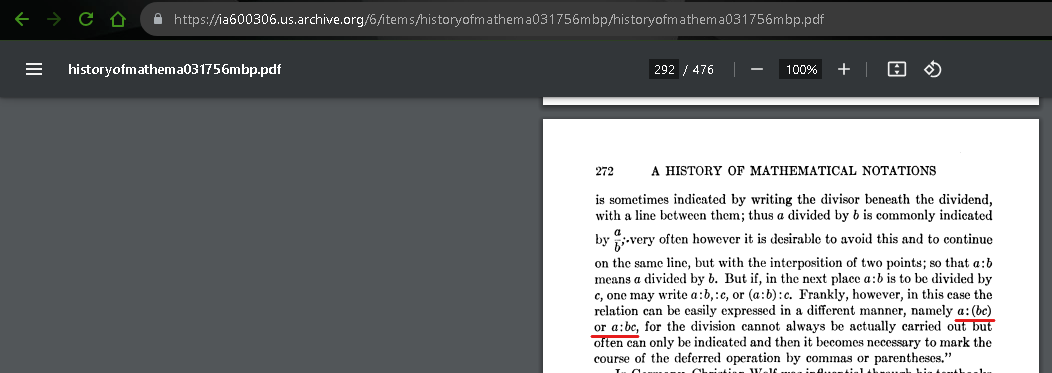
I think I’m gonna trust someone from Harvard over your as-seen-on-TV looking ass account, but thanks for the entertainment you’ve provided by trying to argue with some of the actual mathematicians in here
I think I’m gonna trust someone from Harvard
So you’re going with the appeal to authority argument - ok, got it.
But if you’re gonna do that then make sure you check out Cajori’s credentials, since that’s, you know, who we both quoted.
argue with some of the actual mathematicians in here
You mean the dude who claimed to be, and was quoting wikipedia? BWAHAHAHAHA
That’s cool, but still wrong :3
Everyone in this threading referencing PEMDAS and still thinking the answer is 1 are completely ignoring the part of the convention is left to right. Only way to get 1 is to violate left to right on multiplication and division.
The problem is that BIDMAS and its variants are lies-to-children. Real mathematicians don’t use BIDMAS. Multiplication by juxtaposition is extremely common, and always takes priority over division.
Nobody in their right minds would saw 1/2x is the same as (1/2)x. It’s 1/(2x).
That’s how you get 1. By following conventions used by mathematicians at any level higher than primary school education.
Source? I have a hard ass time believing that nobody in their right mind would do pemdas the way you’re supposed to do it xD
Source?
Cajori (1928) for starters, plus any old Year 7 Maths textbook, any era (we know from Lennes letter that textbooks were already doing this in 1917).
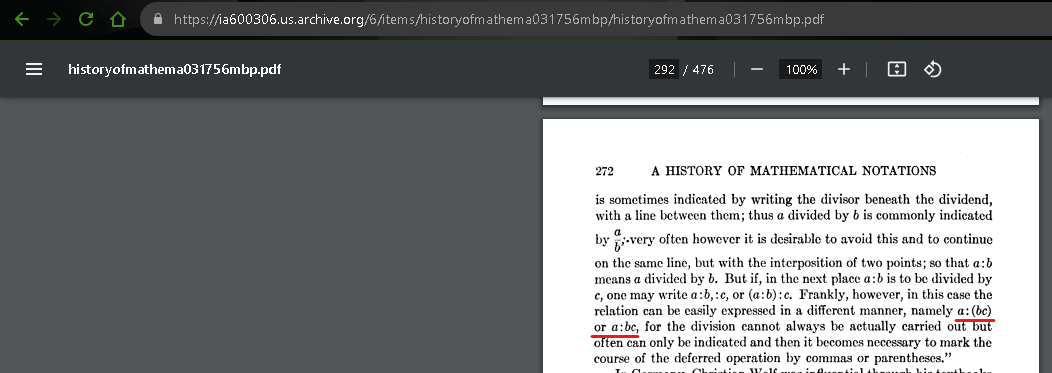
The problem is that you’re thinking of BIDMAS as a set of hard rules, rather than the set of rough guidelines created in the early 20th century by one random teacher for the purposes of teaching 10-year-olds how to do the level of maths that 10-year-olds do.
This video and this one point to some examples of style guides in academia as well as practical examples in the published works of mathematicians and physicists, which are pretty consistent.
If you want to come up with a hard rule, doing BIJMDAS, adding in “multiplication indicated by juxtaposition” with the J, is a much better way to do it than what you learnt when you were 10. But even that’s still best to think of as a handy guideline rather than a hard and fast rule.
That’s cool, but still wrong :3
No fr I had no idea that those acronyms weren’t the whole picture, I just assumed some mathematicians a long time ago decided how that stuff should be written out and that BEDMAS/PEMDAS/whatever contained all the rules in it. Thank you for the info, Idk why this isn’t more widely taught, ig because those acronyms are what all the questions are already written for? It doesn’t seem that hard to just teach it as BEADMAS, where the A refers to numbers adjacent to variables
It doesn’t seem that hard to just teach it as BEADMAS, where the A refers to numbers adjacent to variables
Terms already are taught!
The problem is the /. Usually you’d use a fraction bar, which groups it and makes it unambiguous
Usually you’d use a fraction bar, which groups it and makes it unambiguous
Division (operator) and fraction bar (grouping symbol) aren’t the same. It already is unambiguous.
Only way to get 1 is to violate left to right on multiplication and division
Actually the only way to get 16 is to ignore one of more rules of Maths - sometimes it’s Terms, sometimes it’s The Distributive Law, but always something. If you follow all the rules of Maths you get 1.
Ah damn it. It took me ages to find a calculator app that fits my needs… And now I find out it works like the one on the right.
… the one on the right is correct… that’s a jank ass calculator on the left that doesn’t know how to do order of operations 8/2×(2+2) 8/2x4 4x4 16
the one on the right is correct
No, it isn’t.
8/2×(2+2)
…isn’t the same thing as 8/2(2+2). You separated the term in the denominator, leading the (2+2) to get flipped into the numerator, hence wrong answer.
That would be 8/(2x(2+2)) if we were keeping it all in the denominator. Multiplication happens in the numerator if there are no parenthesis to distinguish it. If thr equation was written like this:
8
2x(2+2)
Then you would also be correct, but I have to respectfully disagree with your analysis.
That would be 8/(2x(2+2)) if we were keeping it all in the denominator
(2x(2+2)) is the same thing as 2(2+2)
I have to respectfully disagree with your analysis
Which means you disagree with how Maths textbooks teach how to do this (see previous link).
There isn’t a multiplication symbol though. By your logic something like
8÷2xwould mean(8÷2)*xbecause order of operationsOr if you read
8÷2√xas(8÷2)*√xJust notate
8÷2(2+2)as8÷2x; x=(2+2)and you get it, you can substitute any complete expression with a variable in an equation and the logic stays the same.You know sometimes both are correct.
You know sometimes both are correct
Nope. That’s what the order of operations rules take care of.
Hiper Calc is the calculator app that I use. It’s very good. When I ran this equation, it actually notified me how the operands should be grouped (weak or strong) and provided two answers. Honestly the whole issue can be avoided if you use more parentheses
the whole issue can be avoided
…by following all the order of operations rules
I don’t understand why people say Maths. Math encompasses every single type of Math. Maths is just wrong.
It’s a shortened form of mathematics, build a bridge and get over it
Ok, but the British also shortened television and made it tele. That makes sense because they took part of the word to do it. If you were going to shorten the word mathematics, why wouldn’t it be math, especially when that would follow what you did with television. Why shorten the word and then add the s from the end for no reason?
why wouldn’t it be math, especially when that would follow what you did with television
Because television is singular (a TV set) and Maths is plural, same as Bros. is the abbreviation of brothers. i.e. when abbreviating a plural you keep the “s”.
Television isn’t a plural word tho? And if they were talking about more than one television I feel like they would absolutely say teles (tellies?), altho not British so 🤷♂️
I don’t understand why people say Maths
Because it’s plural.
every single type of Math
In other words, every branch of Mathematics.
What is math short for?
Because it’s British English
And British English is wrong. Those motherfuckers stick “u” into way too many words.
I’ll have you find that there’s more Americans and statistically likely to have more “motherfuckers” in america
Anymore of this disrespect and I’ll stick “u” into an early grave.
/jk
I feel obligated to say English that comes from England is the only real English. You can keep your Americanese.
That may be, but Math still encompasses all Math so there’s no need to pluralize it.
Mathematics.
The discipline is “mathematics.” It’s really not unreasonable that in some parts of the world, it got shortened to maths.
And the other error present is the incorrect pluralisation. Mathematica means the entire area or domain of knowledge, while mathematics sounds like several lines of thinking, which is weird when we use it as a singular. Maths doesn’t refer to several kinds of math, and that’s confusing.
Mathematica
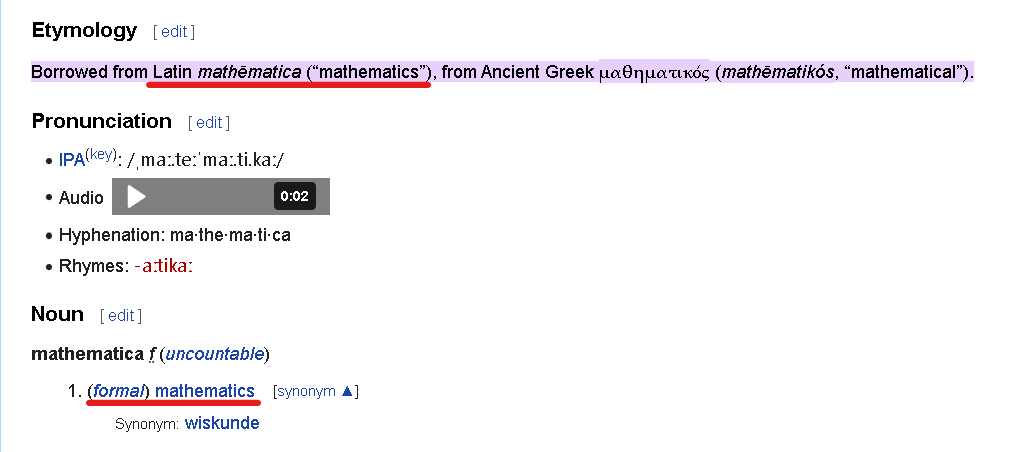
Maths doesn’t refer to several kinds of math
It refers to all branches of Mathematics.
That’s an after the fact justification.
That’s an after the fact justification
You got some sources with dates in them to show it was “after”, and not, you know, before?
16
People in this thread need to watch this: https://youtu.be/lLCDca6dYpA
People in this thread need to watch this: https://youtu.be/lLCDca6dYpA
Debunked here. She managed to never once refer to an actual Maths textbook! Spoiler alert: everyone who has claimed it’s “ambiguous” has done the same thing - no references to any Maths textbooks.
If you think I’m navigating that mess of cross linked posts, well, you’re in for a surprise.
You’re really late to this thread.
She didn’t reference any math textbooks because she made the video for commoners, aka not math majors. Her explanations make sense even if they’re technically wrong from the perspective of pure mathematics.
Unfortunately, I don’t think many people are going to see your reply, and fewer still will deal with the format you’ve chosen to present it in; an even smaller subset will likely understand the concepts you’re trying to explain.
Unfortunately, posting this, so long after the thread was active, linking to your own social media as a reference, seems a lot more like attention seeking behavior. The kind of thing I would expect from a bot or phishing attack, especially since you seem to have copy/pasted the reply on several comments. It’s like you searched for the YouTube link and just vomitted the same reply on every reference to it. That’s bot behavior.
I’m not saying you’re actually a bot, or that anything you’ve posted is incorrect at all. It just seems suspect.
you’re in for a surprise
I’m not actually. A lot of people don’t want to confront evidence that they’re wrong.
She didn’t reference any math textbooks because she made the video for commoners, aka not math majors.
Did you notice she’s a Physics major? In other words, she doesn’t have any Maths textbooks to reference.
Her explanations make sense
So, even when she couldn’t explain why one calculator “sometimes obeys juxtaposition, sometimes doesn’t”, that still made sense to you?
technically wrong
Bingo!
I don’t think many people are going to see your reply
These comments are going to show up in search results for the rest of eternity, so I’m quite happy to debunk the disinformation in it.
you seem to have copy/pasted the reply on several comments
3 different people referred to the same video, so yeah I did something I don’t normally do and copy/pasted for those 3 people. Read my other replies and you’ll find they’re all specific to the person I’m replying to.
It’s like you searched for the YouTube link
No, I’ve had multiple people tell me about it previously, as “proof” that Maths is ambiguous, hence why I wrote a thread debunking the claims she (and others) made.
It just seems suspect
It’s all legit, so feel free to go back and read what I’ve written given that context.
Here is an alternative Piped link(s):
https://piped.video/lLCDca6dYpA
Piped is a privacy-respecting open-source alternative frontend to YouTube.
I’m open-source; check me out at GitHub.
This is the best video out there. A lot of people in north america have no idea.
This is the best video out there
Debunked here - she never once refers to an actual Maths textbook!
And the much longer video by the same person:
Problem with PEMDAS: Why Calculators Disagree https://youtu.be/4x-BcYCiKCk
Problem with PEMDAS: Why Calculators Disagree https://youtu.be/4x-BcYCiKCk
Debunked here - she never once refers to an actual Maths textbook!
Here is an alternative Piped link(s):
https://piped.video/4x-BcYCiKCk
Piped is a privacy-respecting open-source alternative frontend to YouTube.
I’m open-source; check me out at GitHub.
I don’t think you encounter this one very often, but the technically correct
-2^2 = -4has a higher chance of ruining your day.You mean x^2 =4 where x=±2
No, you’d expect that -2^2 would equal 4, but calculators solve it as -(2)^2 not (-2)^2. But the case you mentioned is also pretty common.
if you’ve touched polynomials ever, you’d expect the exponent to be before the negation. If you write x³-x² you don’t mean x³ + (-x)² = x³+x², you mean x³-(x²)
this is why I never use ÷ (or more realistically “/”) without explicit brackets denoting order of operations.
this comment section illustrates perfectly why i hate maths so much lmao
love ambiguous, confusing rules nobody can even agree on!
PEMDAS
Parenthesis, exponents, multiplication, division, addition, subtraction.
The rule is much older than me and they taught it in school. Nothing ambiguous about it, homie. The phone app is fucked up. Calculator nailed it.
Left to right. If you’re following ALL of the rules of PEMDAS then the answer is 16
If you’re following ALL of the rules of PEMDAS then the answer is
…1. If you got 16 then there’s one or more rules that you didn’t obey.
Multiplication before division bro.
The division goes last.
Answer is 1.
Right answer but wrong reason. It’s because distribution comes first
Multiplication and division have the same priority, whichever one comes first LTR is the one that gets resolved first, so it’s (8 / 2) * 4
it’s (8 / 2) * 4
It’s 8/2(2+2)=8/(4+4) or 8/2(2+2)=8/2(4)=8/(2x4)
The answer is 1, but the logic you’ve used to get there is a little off. Different groups actually follow different logic, but they usually arrive at the same end-point.
The American Mathematical Society goes:
- Brackets
- Indices
- Multiplication indicated by juxtaposition
- Regular multiplication and division
- Addition and subtraction
While the American Physical Society does
- Brackets
- Indices
- Multiplication
- Division
- Addition and subtraction
In both cases, addition and subtraction are equal in priority (this solves the problem brought up by a different comment where following primary school BIDMAS would mean 8-4+2=2). In one case (and this is the way I prefer to do it) they solve the problem by declaring that implicit multiplication is done before division, but explicit multiplication with the × sign follows the same rules you would have learnt in primary school. The other says all multiplication is done before division, including explicit multiplication.
follows the same rules you would have learnt in primary school
It’s never that - that’s how people are getting the wrong answer. In high school you get taught about The Distributive Law.
The comment from subignition explains that the phone’s answer, 16, is what you get by strictly following PEMDAS: the rule is that multiplication and division have the same precedence, and you evaluate them from left-to-right.
The calculator uses a different convention where either multiplication has higher priority than division, or where “implicit” multiplication has higher priority (where there is no multiply sign between adjacent expressions).
16, is what you get by strictly following PEMDAS
except 1 is what you get from strictly following PEMDAS. If you got 16 then you missed one of more rules.
the rule is that multiplication and division have the same precedence, and you evaluate them from left-to-right
Go back and read your link again. You’ll find they’re obeying The Distributive Law. i.e. solve all brackets first, from inner-most out.
“implicit” multiplication
But explicit multiplication is part of the parenthesis, so still comes before division or exponent
The parentheses step only covers expressions inside parentheses. That’s 2 + 2 in this case. The times-2 part is outside the parentheses so it’s evaluated in a different step.
The parentheses step only covers expressions inside parentheses
No, it doesn’t
rules nobody can even agree on!
All the Maths textbooks agree
lol, math is literally the only subject that has rules set in stone. This example is specifically made to cause confusion. Division has the same priority as multiplication. You go from left to right. problem here is the fact that you see divison in fraction form way more commonly. A fraction could be writen up as (x)/(y) not x/y (assuming x and y are multiple steps). Plain and simple.
The fact that some calculator get it wrong means that the calculator is wrongly configured. The fact that some people argue that you do () first and then do what’s outside it means that said people are dumb.
They managed to get me once too, by everyone spreading missinformation so confidently. Don’t even trust me, look up the facts for yourself. And realise that your comment is just as incorrect as everyone who said the answer is 1. (uhm well they don’t agree on 0^0, but that’s kind of a paradox)
math is literally the only subject that has rules set in stone
go past past high school and this isn’t remotely true
there are areas of study where 1+1=1
go past past high school and this isn’t remotely true
But this is a high school Maths question, so “past high school” isn’t relevant here.
…given specific axioms. No rules are being broken.
but which axioms you decide are in use is an arbitrary choice
In modular arithmetic you can make 1+1=0 but I’m struggling to think of a situation where 1+1=1 without redefining the + and = functions.
Not saying you’re wrong, but do you have an example? I’d be interested to see
math is literally the only subject that has rules set in stone
Indeed, it does.
This example is specifically made to cause confusion.
No, it isn’t. It simply tests who has remembered all the rules of Maths and who hasn’t.
Division has the same priority as multiplication
And there’s no multiplication here - only brackets and division (and addition within the brackets).
A fraction could be writen up as (x)/(y) not x/y
Neither of those. A fraction could only be written inline as (x/y) - both of the things you wrote are 2 terms, not one. i.e. brackets needed to make them 1 term.
The fact that some people argue that you do () first and then do what’s outside it means that
…they know all the relevant rules of Maths
look up the facts for yourself
You can find them here
your comment is just as incorrect as everyone who said the answer is 1
and 1 is 100% correct.
well they don’t agree on 0^0
Yes they do - it’s 1 (it’s the 5th index law). You might be thinking of 0/0, which depends on the context (you need to look at limits).
are you drunk?
Knowing the rules of Maths means someone might be drunk? Interesting conclusion.
Fuck it, I’m gonna waste time on a troll on the internet who’s necroposting in te hopes that they actually wanna argue the learning way.
This example is specifically made to cause confusion.
No, it isn’t. It simply tests who has remembered all the rules of Maths and who hasn’t.
I said this because of the confusion around the division sign. Almost everyone at some point got it confused, or is just hell bent that one is corrent the other is not. In reality, it is such a common “mistake” that ppl started using it. I’m talking about the classic
4/2x. Ifx = 2, it is:4/2*2 = 2*2 = 44/(2*2) = 4/4 = 1
Wolfram solved this with going with the second if it is an X or another variable as it’s more intuitive.
Division has the same priority as multiplication
And there’s no multiplication here - only brackets and division (and addition within the brackets).
Are you sure ur not a troll? how do you calculate
2(1+1)? It’s4. It’s called implicit multiplication and we do it all the time. It’s the same logic that if a number doesn’t have a sign it’s positive. We could write this up as+2*(+1+(+1)), but it’s harder to read, so we don’t.A fraction could be writen up as (x)/(y) not x/y
Neither of those. A fraction could only be written inline as (x/y) - both of the things you wrote are 2 terms, not one. i.e. brackets needed to make them 1 term.
I don’t even fully understand you here. If we have a faction; at the top we have
1+2and at the bottom we have6-3. inline we could write this as(1+2)/(6-3). The result is 1 as if we simplify it’s3/3.You can’t say it’s
((1+2)/(6-3)). It’s the same thing. You will do the orders differently, but I can’t think of a situation where it’s incorrect, you are just making things harder on yourself.The fact that some people argue that you do () first and then do what’s outside it means that
…they know all the relevant rules of Maths
You fell into the 2nd trap too. If there is a letter or number or anything next to a bracket, it’s multiplication. We just don’t write it out, as why would we, to make it less readable?
2xis the same as2and that’s the same as2(x).look up the facts for yourself
You can find them here
I can’t even, you linked social media. The #1 most trust worthy website. Also I can’t even read this shit. This guy talks in hashtags. I won’t waste energy filtering out all the bullshit to know if they are right or wrong. Don’t trust social media. Grab a calculator, look at wolfram docs, ask a professor or teacher. Don’t even trust me!
your comment is just as incorrect as everyone who said the answer is 1
and 1 is 100% correct.
I chose a side. But that side it the more RAW solution imo. let’s walk it thru:
8/2(2+2), let’s remove the confusion8/2*(2+2), brackets8/2*(4), mult & div, left -> right4*(4), let go4*4, the only16, answer
BUT, and as I stated above IF it’d be like:
8/2xwithx=2+2then, we kinda decided to put implicit brackets there so it’s more like8/(2x), but it’s just harder to read, so we don’t.And here is the controversy, we are playing the same game. Because there wasn’t a an explicit multilication, you could argue that it should be handled like the scenario with the x. I disagree, you agree. But even this argument of “like the scenario with the x” is based of what Wolfram decided, there are no rules of this, you do what is more logical in this scenario. It can be a flaw in math, but it never comes up, as you use fractions instead of inline division. And when you are converting to inline, you don’t spear the brackets.
well they don’t agree on 0^0
Yes they do - it’s 1 (it’s the 5th index law). You might be thinking of 0/0, which depends on the context (you need to look at limits).
You said it yourself, if we
lim (x->0) y/xthen there is an answer. But we aren’t in limits.x/0in undefined at all circumstances (I should add that idk abstract algebra & non-linear geometry, idk what happens there. So I might be incorrect here).
And by all means, correct me if I’m wrong. But link something that isn’t an unreadable 3 parted mostodon post like it’s some dumb twitter argument. This is some dumb other platform argument. Or don’t link anything at all, just show me thru, and we know math rules (now a bit better) so it shouldn’t be a problem… as long as we are civilised.
side note: if I did some typos… it’s 2am, sry.
I’m talking about the classic 4/2x. If x = 2, it is:
4/2x2 = 2x2 = 4
4/(2x2) = 4/4 = 1
It’s the latter, as per the definition of Terms. There are references to this definition being used going back more than 100 years.
Wolfram solved this with going with the second if it is an X or another variable as it’s more intuitive
Yes, they do if it’s 2x, but not if it’s 2(2+2) - despite them mathematically being the same thing - leading to wrong answers to expressions such as the OP. In fact, that’s true of every e-calculator I’ve ever seen, except for MathGPT (Desmos used to handle it correctly, but then they made a change to make it easier to enter fractions, and consequently broke evaluating divisions correctly).
how do you calculate 2(1+1)? It’s 4. It’s called implicit multiplication
No, it’s not called implicit multiplication. It’s distribution.
We could write this up as +2*(+1+(+1))
No, you can’t. Adding that multiplication has broken it up into 2 terms. You either need to not add the multiply, or add another set of brackets if you do, to keep it as 1 term.
I can’t think of a situation where it’s incorrect
If a=2 and b=3, then…
1/axb=3/2
1/ab=(1/6)
If there is a letter or number or anything next to a bracket, it’s multiplication
No, it’s distribution. Multiplication refers literally to multiplication signs, of which there aren’t any in this expression.

2x is the same as 2*x
No, 2A is the same as (2xA). i.e. it’s a single Term. 2xA is 2 Terms (multiplied).
If a=2 and b=3, then…
axb=2x3 (2 terms)
ab=6 (1 term)
This guy talks in hashtags.
Only in the first post in each thread, so that people following those hashtags will see the first post, and can then click on it if they want to see the rest of the thread. Also “this guy” is me. :-)
Grab a calculator, look at wolfram docs, ask a professor or teacher
I’m a Maths teacher with a calculator and many textbooks - I’m good. :-) Also, if you’d clicked on the thread you would’ve found textbook references, historical Maths documents, proofs, the works. :-)
8/2(2+2), let’s remove the confusion
8/2*(2+2), brackets
8/2*(4), mult & div, left -> right
4*(4), let go
2 mistakes here. Adding the multiplication sign in the 2nd step has broken up the term in the denominator, thus sending the (2+2) into the numerator, hence the wrong answer (and thus why we have a rule about Terms). Then you did division when there was still unsolved brackets left, thus violating order of operations rules.
it’s more like 8/(2x), but it’s just harder to read, so we don’t
But that’s exactly what we do (but no extra brackets needed around 2x nor 2(2+2) - each is a single term).
you could argue that it should be handled like the scenario with the x
Which is what the rules of Maths tells us to do - treat a single term as a single term. :-)
there are no rules of this
Yeah, there is. :-)
you use fractions instead of inline division
No, never. A fraction is a single term (grouped by a fraction bar) but division is 2 terms (separated by the division operator). Again it’s the definition of Terms.
And by all means, correct me if I’m wrong
Have done, and appreciate the proper conversation (as opposed to those who call me names for simply pointing out the actual rules of Maths).
link something that isn’t an unreadable
No problem. I t doesn’t go into as much detail as the Mastodon thread though, but it’s a shorter read (overall - with the Mastodon thread I can just link to specific parts though, which makes it handier to use for specific points), just covering the main issues.
as long as we are civilised
Thanks, appreciated.
Idk where you teach, but I’m thankful you didn’t teach me.
Let me quizz you, how do you solve
2(2+2)^2? because acording to your linked picture, because brackets are leftmost you do them first. If I were to believe you:(2*2+2*2)^2(4+4)^2, = 64
but it’s just simply incorrect.
2(4)^2, wow we’re at a2x^22*16= 32
The thing that pisses me off most, is the fact that, yes. Terms exists, yes they have all sorts of properties. But they are not rules, they are properties. And they only apply when we have unknows and we’re at the most simplified form. For example your last link, the dude told us that those terms get prio because they are terms!? There are no mention of term prio in the book. It just simply said that when we have a simplified expression like:
2x^2+3x+5we call2x^2and3xand5terms. And yes they get priority, not because we named them those, but because they are multiplications. These help us at functions the most. Where we can assume that the highest power takes the sign at infinity. Maybe if the numbers look right, we can guess where it’d switch sign.I don’t even want to waste energy proofreading this, or telling you the obvious that when we have a div. and a mult. and no x’s there really is no point in using terms, as we just get a single number.
But again, I totally understand why someone would use this, it’s easier. But it’s not the rule still. That’s why at some places this is the default. I forgot the name/keywords but if you read a calculator’s manual there must be a chapter or something regarding this exact issue.
So yeah, use it. It’s good. Especially if you teach physics. But please don’t go around making up rules.
As for your sources, you still linked a blog post.
Off topic, but the rules of math are not set in stone. We didn’t start with ZFC, some people reject the C entirely, then there is intuitionistic logic which I used to laugh at until I learned about proof assistants and type theory. And then there are people who claim we should treat the natural numbers as a finite set, because things we can’t compute don’t matter anyways.
On topic: Parsing notation is not a math problem and if your notation is ambiguous or unclear to your audience try to fix it.
the rules of math are not set in stone
The rules around order of operations are!
if your notation is ambiguous or unclear to your audience try to fix it
Nothing ambiguous in this expression.
If we had 1/2x, would you interpret that as 0.5x, or 1/(2x)?
Because I can guarantee you almost any mathematician or physicist would assume the latter. But the argument you’re making here is that it should be 0.5x.
It’s called implicit multiplication or “multiplication indicated by juxtaposition”, and it binds more tightly than explicit multiplication or division. The American Mathematical Society and American Physical Society both agree on this.
BIDMAS, or rather the idea that BIDMAS is the be-all end-all of order of operations, is what’s known as a “lie-to-children”. It’s an oversimplification that’s useful at a certain level of understanding, but becomes wrong as you get more advanced. It’s like how your year 5 teacher might have said “you can’t take the square root of a negative number”.
An actual mathematician or physicist would probably ask you to clarify because they don’t typically write division inline like that.
That said, Wolfram-Alpha interprets “1/2x” as 0.5x. But if you want to argue that Wolfram-Alpha’s equation parser is wrong go ahead.
they don’t typically write division inline like that
Yes we do.
But if you want to argue that Wolfram-Alpha’s equation parser is wrong go ahead
Dude, this thread is four months old and I’ve gotten several notifications over the past week from you sporadically responding to comments I barely remember making. Find something better to do with your time than internet argument archeology. I’ll even concede the point if it helps make you go away.
Thanks for the correction, you are right.
Thanks for the correction, you are right
The point is the correction, not who made it. Almost every e-calculator is wrong, so people need to stop trusting them. They’re no more accurate than GPT. Use a proper calculator.
I don’t care.
I will happily point out that Wolfram Alpha does this wrong. So do TI calculators, but not Casio or Sharp.
Go to any mathematics professor and give them a problem that includes 1/2x and ask them to solve it. Don’t make it clear that merely asking “how do you parse 1/2x?” is your intent, because in all likelihood they’ll just tell you it’s ambiguous and be done with it. But if it’s written as part of a problem and they don’t notice your true intent, you can guarantee they will take it as 1/(2x).
Famed physicist Richard Feynman uses this convention in his work.
In fact, even around the time that BIDMAS was being standardised, the writing being done doing that standardisation would frequently use juxtaposition at a higher priority than division, without ever actually telling the reader that’s what they were doing. It indicates that at the time, they perhaps thought it so obvious that juxtaposition should be performed first that it didn’t even need to be explained (or didn’t even occur to them that they could explain it).
According to Casio, they do juxtaposition first because that’s what most teachers around the world want. There was a period where their calculators didn’t do juxtaposition first, something they changed to because North American teachers were telling them they should, but the outcry front the rest of the world was enough for them to change it back. And regardless of what teachers are doing, even in America, professors of mathematics are doing juxtaposition first.
I think this problem may ultimately stem from the very strict rote learning approach used by the American education system, where developing a deeper understanding of what’s going on seems to be discouraged in favour of memorising facts like “BIDMAS”.
To be clear, I’m not saying 1/2x being 1/(2x) rather than 0.5x is wrong. But it’s not right either. I’m just pretty firmly in the “inline formulae are ambiguous” camp. Whichever rule you pick, try to apply it consistently, but use some other notation or parenthesis when you want to be clearly understood.
The very fact that this conversation even happens is proof enough that the ambiguity exists. You can be prescriptive about which rules are the correct ones all you like, but that’s not going to stop people from misunderstanding. If your goal is to communicate clearly, then you use a more explicit notation.
Even Wolfram Alpha makes a point of restating your input to show how it’s being interpreted, and renders “1/2x” as something more like
1 - x 2to make very clear what it’s doing.
Even Wolfram Alpha makes a point of restating your input to show how it’s being interpreted
This is definitely the best thing to do. It’s what Casio calculators do, according to those videos I linked.
My main point is that even though there is theoretically an ambiguity there, the way it would be interpreted in the real world, by mathematicians working by hand (when presented in a way that people aren’t specifically on the lookout for a “trick”) would be overwhelmingly in favour of juxtaposition being evaluated before division. Maybe I’m wrong, but the examples given in those videos certainly seem to point towards the idea that people performing maths at a high level don’t even think twice about it.
And while there is a theoretical ambiguity, I think any tool which is operating counter to how actual mathematicians would interpret a problem is doing the wrong thing. Sort of like a dictionary which decides to take an opinionated stance and say “people are using the word wrong, so we won’t include that definition”. Linguists would tell you the job of a dictionary should be to describe how the word is used, not rigidly stick to some theoretical ideal. I think calculators and tools like Wolfram Alpha should do the same with maths.
Linguists would tell you the job of a dictionary should be to describe how the word is used, not rigidly stick to some theoretical ideal. I think calculators and tools like Wolfram Alpha should do the same with maths.
You’re literally arguing that what you consider the ideal should be rigidly adhered to, though.
“How mathematicians do it is correct” is a fine enough sentiment, but conveniently ignores that mathematicians do, in fact, work at WolframAlpha, and many other places that likely do it “wrong”.
The examples in the video showing inline formulae that use implicit priority have two things in common that make their usage unambiguous.
First, they all are either restating, or are derived from, formulae earlier in the page that are notated unambiguously, meaning that in context there is a single correct interpretation of any ambiguity.Second, being a published paper it has to adhere to the style guide of whatever body its published under, and as pointed out in that video, the American Mathematical Society’s style guide specifies implicit priority, making it unambiguous in any of their published works. The author’s preference is irrelevant.
Also, if it’s universally correct and there was no ambiguity in its use among mathematicians, why specify it in the style guide at all?
It doesn’t have to be confusing. This particular formula is presented in a confusing way. Written differently, the ambiguity is easily resolved.
This particular formula is presented in a confusing way
No, it isn’t. You just have to obey all the relevant rules of Maths
This is more language/writing style than math. The math is consistent, what’s inconsistent is there are different ways to express math, some of which, quite frankly, are just worse at communicating the mathematical expression clearly than others.
Personally, since doing college math classes, I don’t think I’d ever willingly write an expression like that exactly because it causes confusion. Not the biggest issue for a simple problem, much bigger issue if you’re solving something bigger and need combine a lot of expressions. Just use parentheses and implicit multiplication and division. It’s a lot clearer and easier to work with.
implicit multiplication
Something about the way this thread was written was kind of confusing, so I don’t really get what their point was. Is it just that the terminology is wrong? Or am I missing something?
Like, whatever you call it, a x b, a*b, ab, and a(b) are all acceptable notations to describe the operation “multiply a and b.” Some are nicer to use than others depending on the situation.
Something about the way this thread was written was kind of confusing,
Ok, sorry about that. I’m more than happy to update it if you want to give me some constructive feedback on what was confusing about it. Note though that this was the 3rd part in the series, and maybe you didn’t go back and read the previous 2 parts? They start here
Is it just that the terminology is wrong? Or am I missing something?
Yes and yes. :-) The 2 actual rules of Maths that apply here are Terms and The Distributive Law. These are 2 different rules of Maths - neither of which is “multiplication” - and so when lumping them together as “implicit multiplication” you end up with unpredictable, and usually wrong, answers. The only way to always get the right answer is to follow the actual rules of Maths.
a x b, a*b, ab, and a(b) are all acceptable notations to describe the operation “multiply a and b.”
No, they’re not. The first two are multiplications, the second two are Terms. Note that a Term is a product, the result of a multiplication. In the mnemonics, “Multiplication”" refers literally to multiplication signs, and nothing else.
Ok, sorry about that. I’m more than happy to update it if you want to give me some constructive feedback on what was confusing about it. Note though that this was the 3rd part in the series, and maybe you didn’t go back and read the previous 2 parts? They start here
NP. I’m not really great at giving writing advice, so can’t really help there. Something about it just didn’t click when I read it. The extra context you linked did help a bit.
As far as the issue: After reading it I think it does just seem to be a matter of terminology mixed with problems that arise with when you need to write math expressions inline in text. If you can write things out on paper or use a markdown language, it’s really easy to see how a fractional expression is structured.
8
2(1+3)
is a lot easier to read than 8/2(1+3) even if they technically are meant to be evaluated the same. There’s no room for confusion.
And as for distributive law vs multiplication, maybe this is just taking for granted a thing that I learned a long time ago, but to me they’re just the same thing in practice. When I see a(x+1) I know that in order to multiply these I need to distribute. And if we fill in the algebraic symbols for numbers, you don’t even need to distribute to get the answer since you can just evaluate the parentheses then use the result to multiply by the outside.
Conversely, if I was factoring something, I would need to do division.
ax + a
a
= x+1, thus: a(x+1)
I think we’re basically talking about the same thing, I’m just being a bit lose with the terminology.
And while we’re at it, the best way to make sure there’s no misunderstanding is to just use parenthesis for EVERYTHING! I’m mostly kidding, this can rapidly get unreadable once you nest more than a few parens, although for these toy expressions, it would have the desired effect.
(8)/(2(1+3)) is obviously different than (8/2)(1+3)
8/2(1+3) even if they technically are meant to be evaluated the same
But 8/2(1+3) isn’t a fraction. The / - the computing equivalent of ÷ (which can only be written using Unicode on a computer, so a bit of a pain to use compared to / )- is an operator, which means they’re 2 separate terms. A fraction bar is a grouping symbol, which means it’s 1 term. In this particular case it doesn’t matter, but if it appeared in a bigger expression then it absolutely does matter. The way to write 8/2(1+3) as a fraction inline is to add extra brackets. i.e. (8/2(1+3)) - because brackets are also a grouping symbol.
And as for distributive law vs multiplication, maybe this is just taking for granted a thing that I learned a long time ago, but to me they’re just the same thing in practice
Bu they’re not, for the same reason. Firstly, the Distributive Law isn’t multiplication at all - which only applies literally to multiplication symbols - it applies to bracketed terms (i.e. is a single term which needs to be distributed) - and secondly it applies to a single term, whereas multiplication applies to 2 terms (one before and one after). Anyone who talks about 2(1+3) needing to be “multiplied” has already made the mistake that is going to lead to a wrong answer (unless they just happen to “multiply” before they divide, which is an accidental way to get the right answer).
if I was factoring something
Indeed, that is the precise reason the Distributive Law exists - they are the opposite operation to each other! Anyone who adds a multiplication symbol has broken up the factorised term, again leading to the wrong answer.
I’m just being a bit lose with the terminology
Yeah, and that’s all I was pointing out in the first place - please don’t use “implicit multiplication”. The term itself - i.e. it includes “multiplication” - leads people to do it wrong (because they treat it as multiplication, not brackets, then argue about the precedence of “multiplication”!). It needs to die!
this can rapidly get unreadable once you nest more than a few parens,
Well that’s why the rules of Terms ab=(axb) and The Distributive Law a(b+c)=(a*(b+c))=(ab+ac) exist to begin with - less brackets! :-) Imagine having to write a fraction as (1/(axb)) all the time!
(8)/(2(1+3)) is obviously different than (8/2)(1+3)
Correct, though a lot of people treat it as the latter (yet another way to do it wrong - doing division before brackets) because they figure the 8/2 is “outside the brackets”, but in fact only the 2 is, because the slash separates them as being 2 terms.
The problem isn’t math, it’s the people that suck at at it who write ambigous terms like this, and all the people in the comments who weren’t educated properly on what conventions are.
write ambigous terms like this
It’s not ambiguous
all the people in the comments who weren’t educated properly on what conventions are
Everyone was taught the rules of Maths - it’s just a matter of who remembers them or not.
Yeah, you could easily make this more straightforward by putting parentheses around 8÷2. It’s like saying literature sucks because Finnegans Wake is incomprehensible.
you could easily make this more straightforward by putting parentheses around 8÷2
But that would be a different expression with a different answer (16 rather than 1). This is the mistake made by the programmer of the e-calc - treats it as though there’s extra brackets there when there isn’t.
Huge shout out to the jaded AF high school math teachers that don’t give a fuck any more!
They do care. The issue is everyone argues about it without even asking Maths teachers about it to being with! I guarantee (I’ve seen it myself) literally every blog you read which says this is “ambiguous”, without exception they never mention Maths textbooks or Maths teachers (because then they wouldn’t be able to bombastically declare “This is ambiguous!”).























